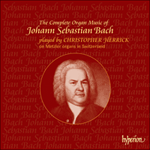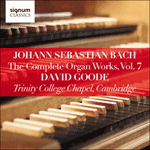
Welcome to Hyperion Records, an independent British classical label devoted to presenting high-quality recordings of music of all styles and from all periods from the twelfth century to the twenty-first.
Hyperion offers both CDs, and downloads in a number of formats. The site is also available in several languages.
Please use the dropdown buttons to set your preferred options, or use the checkbox to accept the defaults.

| David Goode (organ)» More |
BWV574 presents a four-part exposition, later adding a second theme with another exposition of its own. The two themes then combine as a double fugue in which inversion of the material extends its possibilities. In the manuscript there is a final ‘toccata’ section which bears little detectable thematic relationship to the preceding music. Alternative versions of this fugue exist (BWV574a and b), the former dispensing with the toccata section altogether, and being the version here played. The existence of these remains a mystery. Although Schweitzer claims to see in this fugue Bach’s concern to ‘design in simpler, broader lines’, Williams considers it an expansion of a complete existing work, as with BWV579.
from notes by Francis Pott © 1995
BWV574 weist eine vierteilige Exposition auf, zu der später ein zweites Thema mit einer weiteren, eigenen Exposition hinzutritt. Die beiden Themen werden dann als Doppelfuge kombiniert, in der eine stoffliche Umkehrung die musikalischen Möglichkeiten erweitert. Im Manuskript gibt es einen ‘Toccata’-Abschnitt gegen Schluß, der kaum einen erkennbaren thematischen Bezug zur voraufgehenden Musik besitzt. Es existieren alternative Fassungen dieser Fuge (BWV574a und b), Die erste dieser Fassungen läßt den Toccata-Teil ganz fallen, und es ist diese Fassung, die hier zu hören ist. Der Grund für diese alternativen Fassungen ist ungeklärt. Zwar behauptet Schweitzer, in dieser Fuge Bachs Bemühungen zu erkennen, ‘in schlichteren, breiteren Zügen zu entwerfen’, doch betrachtet Williams sie, wie bei BWV579, als Erweiterung eines vollständigen vorhandenen Werkes.
aus dem Begleittext von Francis Pott © 1995
Deutsch: Angelika Malbert
 Bach: The Complete Organ Works Bach: The Complete Organ Works‘Let me say without hesitation that Herrick’s performances are models of clarity, accuracy, precision and musicality … this is a complete Bach th ... ‘Herrick is one of the few organists who does justice to these difficult, elusive pieces … What a singular joy to hear the organ played with such ...» More |
 Bach: The Complete Organ Works, Vol. 7 Bach: The Complete Organ Works, Vol. 7David Goode continues his Bach series on the Metzler organ of Trinity College Chapel, Cambridge.» More |

